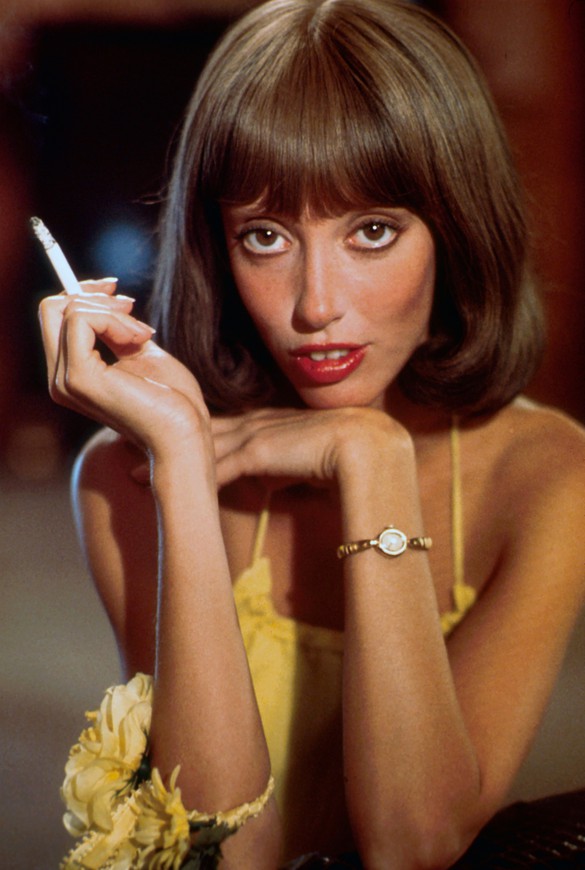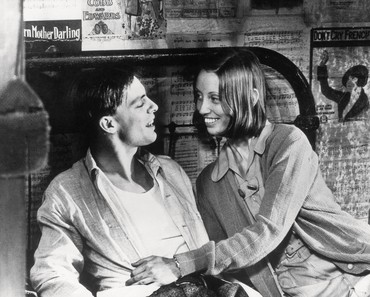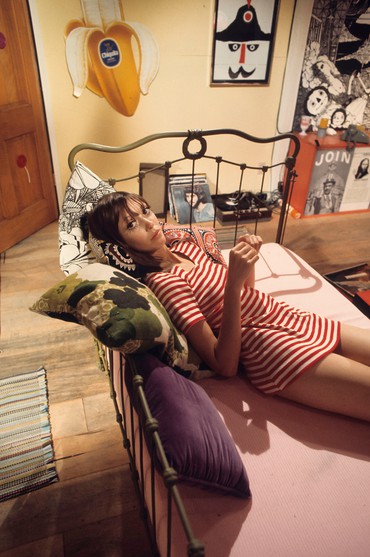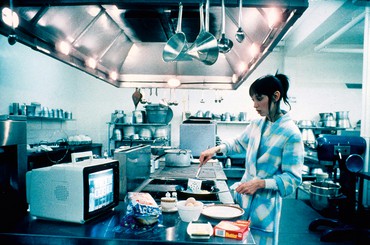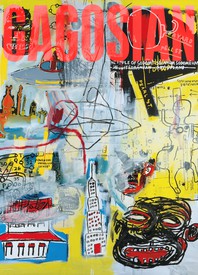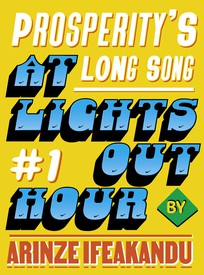And therefore the rich poets . . . have obviously no limits to their work except the limits of their lifetime, and resemble a mirror carried through the street, ready to render an image of every created thing.
—Ralph Waldo Emerson, “The Poet,” 1844
I observe people. Ever since I was a child, I’ve loved to watch people, their movements, and their attitudes. I think that’s how I learned to act. I took two or three acting lessons from Lee Strasberg, but I found it to be not necessary for me. Not as beneficial for me on a personal level. I guess I’m instinctive. I just do it and feel it instinctively. I use the moment.
—Shelley Duvall, 1977
There’s no straight path to kindness, no formula to realize it. You seem to fall into it, it glows from you based on how you were born or whom you’ve hung around. Shelley Duvall is breathtaking precisely because there doesn’t seem to be an unkind bone in her being. And most of the people who were lucky enough to orbit her vicinity were that much hipper to kindness in the raw precisely because she was its rare source. She seems preternaturally incapable of vengeance, pretension, boredom. And that’s because she never imagined for a second she would grow up to become a big deal. She was a star despite her intentions. She never cut herself off, icily, as the greats did before her (Clark Gable, Cary Grant, Marilyn Monroe), yet she towers alongside them. She’s the quintessence of New Hollywood but she went farther than any of those fancy auteurs: Brian De Palma, Martin Scorsese, even her beloved Robert Altman, who still had to cut off the world with their four-sided shots. Shelley Duvall glides off the frame into lowercase divinity itself. When Jean Epstein raved about photogénie, the cosmic simplicity of a movie face and the secrets of life contained therein, he had no idea he was dreaming of Shelley Duvall.1
Pauline Kael, who normally pours adoration on her pet actors like hotcake syrup, is flummoxed when it comes to Duvall: “She looks like no one else and she acts like no one else. Shelley Duvall may not be an actress, exactly, but she seems to be able to be herself on the screen in a way that nobody has ever been before. She doesn’t appear to project—she’s just there.”2 It’s the old line that’s been trotted out ever since the first movie-mad Europeans caught a glimpse of Lillian Gish: She doesn’t act, she is.3 What Kael detects, though, is unique in the grand scheme of movie star history. Facing the one-woman phenomenon of acting that was Shelley Duvall, the pinning-down language of the critic collapses in exhilaration. From the moment Duvall burst onto the screen in Brewster McCloud (1970), Kael required an entire decade to adequately evoke her spirit, in a review of Popeye (1980) in which she praises Shelley as equal to and more than the sum of her kooky parts:
There are no forebears or influences that would help to explain Shelley Duvall’s acting; she doesn’t seem to owe anything to anyone. She’s an original who has her own limpid way of doing things—a simplicity that isn’t marred by conventional acting technique, but that by now she has adapted to a wide range of characters. . . . Shelley Duvall takes the funny-page drawing of Olive Oyl and breathes her own spirit into it. Possibly she can do this so simply because she accepts herself as a cartoon to start with, and, working from that, goes past it. So far past that we begin to find chic in her soft, floppy white collars and her droopy elongated skirts.4
Duvall seemed to float about with an oh-gosh bemusement in defiant ignorance of the constantly jaded 1970s. The mood of New Hollywood films in Duvall’s time was directly opposed to her own, what with the bias toward a clean pictorial cynicism (e.g., the paranoid landscapes of cinematographer Gordon Willis) and a gritty reality consciously pitched against the idealizations of classical Hollywood (not the “pretty lies” fed to the previous generation by Humphrey Bogart and Lauren Bacall, whose romance was too perfect for the new movie brats). We’ve unquestioningly anointed the doom-laden Chinatown (1974) as the perfect realization of wretched US history on the silver screen, the popular imagination anointing the Great American Screenplay award to this perfectly coiffed noir, the movie that tells it like it is, Hollywood’s greatest achievement (along with the equally nihilist Godfather movies). Now I’m told that Ben Affleck has decided to make a useless film out of the recent superfluous book of the making of Chinatown, in a desperate gambit to keep reveling in the comfortable Roman Polanski–Robert Towne–Jack Nicholson–Faye Dunaway darkness over and over again. So, too, are we obsessed with the defeatist popular visions of that era: Taxi Driver, Mikey and Nicky, The Panic in Needle Park, The Godfather, The Long Goodbye, The Last Picture Show, The French Connection, Bring Me the Head of Alfredo Garcia, New York, New York, Halloween, Blue Collar, and Deliverance: a storm of bad vibes. But that bleakness was foreign to Duvall (the star of stars in New Hollywood), who somehow weathered the storm for miraculously long—until Stanley Kubrick got his hands on her, forging a masterpiece from the flesh and sweat of her battered will.5
Beneath her sunny exterior, Shelley never lost track of the morbid truths that so trapped the lives of the bitter Petra von Kant and her creator, Rainer Werner Fassbinder: that “people are terrible” (Bernice Bobs Her Hair), that they are “hard and brutal” (The Shining), and that “everyone is replaceable” (3 Women). Without mucking about in generic lethargy at the state of an ugly world, she accepted and skated across these jaded truisms with her wide eyes and her warm grin and her oh-dear-oh-well attitude, all so bafflingly transparent and lovely. You want to hang out with Shelley’s characters at bars, covertly jotting down ideas for your next wardrobe or folksy aphorism. At the same New York bars, after long rants about disappointing people, toxic love, and other daily sociopolitical abuse, my friends and I will suddenly raise a toast in the name of, who else, Shelley Duvall, our oasis in despair. It’s for no reason other than to hope she’s on the mend, that we may stave off the dross of dispassion for as long as she did. When bars come back, I’ll toast to no one else.
Herein lies the genius of Duvall, who generously gives such huge chunks of her real twangy warmth without ever giving the viewer or the camera a gram of her real self.
Pure-hearted—that’s what gets me about Shelley. There was no reason she had to be that goddamn cheerful all the time! In her movies with Altman, the grand bulk of her work, we grow intimate with her eccentric characters stuck in lose-lose situations: tour guides by day, getaway drivers by night, falling for bird brains (Brewster McCloud, 1970); sex workers in a love-shot, turn-of-the-century tundra (McCabe & Mrs. Miller, 1971); ’30s ragdolls who play Gangbusters with kindred boys marked for death (Thieves Like Us, 1974); the First Lady as a piece of cheap, kitschy china (Buffalo Bill and the Indians, or Sitting Bull’s History Lesson, 1976); a hungry body in search of an identity (Nashville, 1975); a hungry identity in search of a body (3 Women, 1977). Not to mention her non-Altman outsiders: F. Scott Fitzgerald’s frumpy sad girl torn apart by Yale-Princeton-Harvard conformists (Joan Micklin Silver’s Bernice Bobs Her Hair, 1976), a troubled wife who loses her husband to drink and her mind to the ghosts of territory (Kubrick’s The Shining, 1980), someone in a Woody Allen film (Annie Hall, 1977). None of these are hopeful situations; yet in all of them we grow to love Shelley’s resilience, she of the gnarly boots, the weaving walk, and the outsized heart. We love her whether she’s playing a knotty human or a cartoon—and sometimes, incredibly, she’s both (as in Altman’s Popeye, 1980—one of the only good, genuinely original comic book movies).
She was born in Houston on July 7, 1949. (That makes her a Cancer; are we surprised?) According to a 1977 New York Times profile, she admitted to a mundane childhood: “I was a bookworm who loved science and art.”6 She studied, of all things, the science of food for two years at a Houston junior college, majoring in nutrition and diet therapy. Her dream in life, in her words, was to “make great discoveries in food research to help mankind.”7
Dr. Duvall would be working on rice at Rice today had she not gone to a fate-defining party in 1970. It was to celebrate her recent engagement to a local Houston artist, Bernard Sampson (whom she later divorced after four years but with whom she remained good friends). At the party she was approached by members of a local film crew who were scouting actors to appear in their movie. Thinking the offer was an invitation to appear in a porno, Duvall and her parents immediately said no, but she was told more: the movie was Brewster McCloud and the director was Altman, who had just wrapped production on what would become his meal ticket to Hollywood, the ribald war comedy MASH (1970). Duvall was asked if she had any experience in front of a movie camera; she did not. In fact, she said, “I know nothing about acting. I’ve never even seen a play.”8 That didn’t faze Altman, who, after a conversation with her in which he figured out that her friendly demeanor was not an act, cast the greenhorn as the main female love interest who seduces Bud Cort on his path to becoming the first human to spread wings and fly. The movie, a zany outlier in Altman’s oeuvre, failed either to impress critics or to entice an audience and has been wrongly dismissed as a lull in between MASH and Altman’s revisionist western McCabe & Mrs. Miller.9 But it’s a beautiful work, a sick specimen of US culture in its own right: twisted, deranged, nihilist, vile, bitter, and bold.
Of course, the MVP’s are Duvall and her incantatory delivery, in that Houston drone of hers, of lines like: “Oh, diarrhea. That’s tough. I’m a race-car driver.” In cartooned anticipation of her 3 Women identity crisis, she plays an absurd number of roles, all at different temperatures: a tour guide of the then new Houston Astrodome (warm, nice, soft), a cop-hating drag racer like Jean-Pierre Léaud’s manic numbskull in Jerzy Skolimowski’s Le départ (asphalt hot, spiky, a menace to society), and a teenybopper with mile-long eyelashes, a candy-cane blouse, and 3D-printed green and purple lollipops tacked onto her bedroom walls (lukewarm, a lousy caricature). Her eyes are strangely, gently open all the time—not the bug eyes, forced open by Clockwork Orange–style terrorism, for which she would become iconic in The Shining. Here she demonstrates how the actor doesn’t need to be bodily present to successfully command film space, her voice a disembodied presence that haunts the Astrodome via its PA system. Her voice spews out inane non sequiturs, real spit takes that might escape less eagle-eared viewers: “There are bathrooms every fifty feet—but they’re not really bathrooms, ya know—they don’t have a tub or anythin’ like that.” Later, brainwashed by the Houston Police Department and her own tragically misplaced horniness, she suggests that Cort’s Brewster patent his flying wings so that he can become a millionaire and they can get married and be on top of the world, a convoluted but charming metaphor about the impurity of first loves taken in the name of glory-seeking capital. In Brewster, Duvall gives Altman’s miserly cynicism its goofy face and solid dimension.
But her shades of vulnerability, a soft strength, balance out Altman’s perpetual disappointment in stupid Americans. Duvall crafts an extraordinary balancing act in Thieves Like Us: she, Keechie, a Depression-era teen who cribs her identity from the chatter of radio programs and the emaciated pigtailed girls in Coca-Cola ads, has been lied to by her pacifist-romantic-bank-robber boyfriend Bowie (Keith Carradine). She hollers “Liar!” to his face in a fit of unusual anger; she sulks about their cold wood-paneled motel room; she decides to leave him; she packs a valise. Suddenly, in a crappy makeup mirror more appropriate for a fun house or an Orson Welles movie than for a gangster melodrama set in the South of the ’30s, Keechie notices an out-of-place cowlick on the left side of her hair. She tousles her bob, trying to straighten it. Then she looks at her mirrored face. The image is frightening, grotesque. Finally she says out loud, not really to Bowie, not really to her mirrored self, even: “I don’t wanna leave you.” To us it’s clear that the mirror is the problem, but like the movie screen, it only slightly exaggerates the imperfections the viewer detects in her physical self. Trying to conform to the distorted looking glass, she can only see the neck of a strangled goose, a badly lopsided bob (like Bernice’s in the Silver film), eyes pinched in, sugary and too-thin lips to match Coke-guzzling body and soul. “I don’t wanna leave you”—because who’ll love this later like you do now?
In her films, Duvall is consistently the target of degrading, passive-aggressive barbs about her body. A year after Thieves, she and Carradine reunite in Nashville; now it’s 1975, he’s a hotshot country/folk superstar, she’s a wannabe groupie from LA. She wears wild platform boots and an array of campy dresses and hairdos: a hippie girl’s wig of silver gray, a rusty-brown afro the color of vintage Dr Pepper ads. But to Carradine they only serve to distract from the obvious: “Damn girl, you better get off that diet before you ruin yourself.” Always the cracks about being “the Texas Twiggy.” Always the sneers at her haggard look in her most famous character, the screaming Wendy Torrance in The Shining, hair falling out of her scalp in chunks for the good of cinema. There must have been some trepidation in her acceptance of her final role in an Altman film, the role that (in his triggering words) she was “born to play”: Olive Oyl in Popeye. Born to play Olive Oyl: that’s also what Duvall was told when she was bullied mercilessly by the more popular, more conventionally pretty jet set of girls at her Houston high school—the jet set her Millie still desperately wants to join in the Freudian mythopoetic desert of 3 Women, years after she’s graduated and none of the cliquery matters.
It was 3 Women that won Duvall the Cannes best-actress award in 1977—and when you see her performance, you understand why. When the merits of American movies in the 1970s are extolled ad nauseam, what’s really being praised are the rambling monologues of Duvall’s Millie in 3 Women. I wish there was an album of these surreal, largely improvised runs of the Duvallian mouth that I could listen to in my headphones all day: “Purple ’n’ yellow are my favorite colors. Like irises. Like flowers. And candlelight. They’re so romantic. Surefire way to win a man in one night: Good atmosphere ’n’ food. Remember that ol’ sayin’? ‘The way to a man’s heart is through his stomach’? Well it’s true lotsa times.” Why does Millie talk and talk and never stop talking, especially when no one around her listens? Out of justified paranoia that to shut up, to stop moving, to stop advertising her banal existence every second of her waking life, is in her day and age not to exist? Out of a need silently mandated by US mores that one must voice every meaningless fact about oneself that no one else could possibly care about: how you prefer your hot dogs (burnt to a crisp in microwave ovens), or the rules of the games you play (Scrabble, but no dirty words, gosh no)?
Millie self-brands as a dinner hostess with the mostest, a ’70s gal with great taste: “Tonight, we’re havin’ pigs-in-a-blanket ’n’ chocolate-puddin’ tarts!” A terrifyingly automatic speechifying machine, she spews out talk for talk’s sake. It’s not really a nightmare for us, because Duvall’s jeez-louise cadences are always a pleasure, even to the hard-to-impress skeptic. But it’s a nightmare for her colleagues—she works at a health spa for the elderly—who are constantly praying that she leave them alone to eat their flavorless tapioca in peace. And the more you dwell on the character Duvall has brought to sad life, the more the nightmare grows. Weaned on color-supplement magazines and nauseatingly romantic TV movies since childhood, Millie is a swell gal-pal: nice, annoyingly self-involved (because American), she is an eerie reflection of the rosy-cheeked, midcentury, TV brand of femininity that so many of the women in Altman’s films rebel against.10 At the end of the day, when Millie leaves work and “converses” with her co-workers, Duvall makes no attempt at conversation. She just stares ahead, trailing an awkward three paces behind them, marching to her car like an abandoned robot programmed to chatter and go—and go she does—and stop she never does—about zebus, penthouse chicken, or an exotic hula dancer who gives $12 lessons at the local Macy’s, “real sexy.” Hers is a kind of disturbing automatism, a mix of kitsch and inexplicable behavioral tics out of Elle (“12 Tips to Be Popular and Get the Guy”), never cohering into a solid movie woman.
But that’s the point! What nerves! What tics! What mess! What won Duvall that award at Cannes was the fact that the tail of her English-mustard-colored dress keeps getting caught in the door of her French-mustard-colored car. (These absurd national divisions are Duvall’s improvisations.) It’s the perfect image of the ’70s woman who wants to seem “with it,” but isn’t—and in fact is gloriously out of it, unlike the bourgeois anti-kink squares who want to be hepcats and whom Paul Mazursky deflated mercilessly in Bob & Carol & Ted & Alice (1969). It makes perfect sense that Sissy Spacek’s inexplicably childish Pinky looks up to Millie, for Millie is the refined copy of a messy image: TV’s glamour girls. Elsewhere, Duvall has no qualms asking the guy she has a crush on to check her neck glands because “they’ve felt swollen all day, ’n’ I’m so taiiired already.” This neither kills the eroticism intended in the come-on, nor stokes it; this is the pure weird, bulldozing and mesmerizing. Neck glands, even! She can’t just say “My neck hurts, it needs a rub, your rub”; she has to push the failed flirtation over the edge into the technical, the grotty, the TMI. And herein lies the genius of Duvall, who generously gives such huge chunks of her real twangy warmth without ever giving the viewer or the camera a gram of her real self. She’s more wont to compel viewers to dissolve their identities totally within her lanky oddballs, in the manner of 3 Women’s mysterious tagline: “1 woman became 2, 2 women became 3, 3 women became 1.” She’s singular, yet you fall into her. She’s not a stable being; you can’t predict what will come out of her mouth, just as one can’t predict what genre 3 Women will morph into next. (3 Women, as I see it, is Altman’s most ambitious film in its total suspension of narrative logic and the conventions of classical movie language.) Duvall is one of the few clear bright presences in Altman, whose world is otherwise defensively hard-shelled, hard to hear, pockmarked with languid zooms from the perspective of a hungover lapsed idealist. Duvall’s Millie is the viewer without a filter, incapable of reading the room, stubbornly resistant to the polite starting- and stopping-points ingrained in all girls like her since they learned to chat.
O Shelley: so many words when your way is best, the backdoor poetry of your smile that can demonstrate to a drip what he’s missing in the art of living. Walt Whitman, in the preface to Leaves of Grass (1855), already had someone like you in mind: “The expression of the American poet is to be transcendent and new. It is to be indirect and not direct or descriptive or epic.” Even when you’re in a bit role, among the Grand Ole Opry crowd of Nashville or the Wild West Show of Buffalo Bill, you’re beaming with such illogical intensity, centering the busy Altmanesque chaos of the crowd with your exuberance. You had no ambitions toward the epic. You wouldn’t be caught dead near gilt culture.11 Give you a Scrabble night and a Coke, country pop and Popeye’s, any day of the week. When you said Kubrick taught you the most about acting, you really meant Acting; for your Shining performance, the element that turned that film into a marvel of terror, the terror was beaten out of you by a director who had little patience or collaborative calm to ease into your understanding of a wife’s horror at her maniac husband, the cabin-fever-induced traumas endured by an independent (unlike, say, the way Altman gently coaxed the same emotions out of you at the climax of 3 Women). For you, acting was not a matter of powerhouse crying, the huffing of plagued rabbits. It was a matter of living your best on a crazy island, on a motorcycle out of Easy Rider, in a rowdy saloon—in short, in a good atmosphere, with good food, but no man (or at least, no man for too long).
In a wonderful Fitzgeraldian scene in Bernice Bobs Her Hair, you taught me how much barbed poison can be contained within the politest reactions imaginable. There, you tolerate Cort’s gnat of a know-it-all Yale boy, that most tedious of creatures, a writer full of energy but self-absorbed in his own problems—all during what he considers to be “the late stages of [his] life” (the boy is nineteen, for Chrissake). Your poetry came out—casually, as usual—with the coy corner-cheeked smirk you gave him in the middle of his screed against a world that doesn’t understand him and that he can’t understand. Your smile, Shelley, was so unconsciously, patiently, generously civil (geared to the Jazz Age, high-society milieu) yet dripping with snark, eye-rolling, a subtle amusement with these highfalutin rich white boys who can only see you, Bernice-qua-Shelley, as the geeky indigenous girl with the crazy hair. You don’t realize that you exist in a separate sphere from all these petty youth; you don’t even realize that you look terrific in a Louise Brooks bob. You don’t realize—or if you do, you couldn’t care less.
Such is your way of being, Shelley, so heartbreakingly kind and trusting even when the world around you will never be. At the end of the day, this, too, was the Altman way, but he gets too much credit—and he would be the first to admit it, the first to point the finger back to you (this rare, rare wisp) as the conscience, the core, of his jaded world—of the world, maybe. To your health, Shelley—and to your poetry, the lilt that I and many others don’t have to strain in the din to overhear.
1For more on Jean Epstein and photogénie see Jean Epstein: Critical Essays and New Translations, Film Theory in Media History, ed. Sarah Keller and Jason N. Paul (Amsterdam: Amsterdam University Press, 2012). Epstein is notably evasive when it comes to defining photogénie, which he describes in the following terms: “For how can one better define the undefinable photogénie than by saying: photogénie is to cinema what color is to painting and volume to sculpture—the specific element of that art” (“The Photogenic Element,” p. 300); “I would describe as photogenic any aspect of things, beings, or souls whose moral character is enhanced by filmic reproduction” (“On Certain Characters of Photogénie,” p. 293).
2Pauline Kael, “Love and Coca-Cola,” The New Yorker, February 4, 1974, quoted here from Kael, Reeling (Boston and Toronto: Little, Brown, an Atlantic Monthly Press Book, 1976), pp. 267–68.
3See, e.g., Béla Balázs’s thoughts on Lillian Gish’s physiognomy and “shattering play of expressions” in D. W. Griffith’s Way Down East (1920): “We would need many printed pages to describe the storms that pass over this tiny, pale face. Reading them would also take up much time. But the nature of these feelings lies precisely in the crazy rapidity with which they succeed one another. The effect of this play of facial expressions lies in its ability to replicate the original tempo of her feelings. That is something that words are incapable of. The description of a feeling always lasts longer than the time taken by the feeling itself. The rhythm of our inner turbulence will inevitably be lost in every literary narrative.” Italics in the original. In Béla Balázs: Early Film Theory, ed. Erica Carter, trans. Rodney Livingstone (New York: Berghan Books, 2010), p. 35.
4Kael, “The Funnies,” The New Yorker, January 5, 1981, p. 80. Available online at https://scrapsfromtheloft.com/2018/03/07/popeye-1980-pauline-kael/ (accessed August 30, 2020).
5For more on Duvall’s and Kubrick’s contentious relationship on set, see Vivian Kubrick’s Making “The Shining”, a 1980 short on the making of the film. In 2011, Lee Gambin conducted an interview with Duvall in which she talks at length about the role (in more retrospectively positive terms); the complete text was published on the website Comingsoon.net in 2016: www.comingsoon.net/horror/features/787573-interview-shelley-duvall-on-the-shining (accessed September 8, 2020).
6Duvall, quoted in Judy Klemesrud, “Shelley Duvall, an Unlikely Star,” New York Times, March 23, 1977. Available online at www.nytimes.com/1977/03/23/archives/shelley-duvall-an-unlikely-star.html (accessed September 8, 2020).
7Ibid.
8Ibid.
9One notable fan of Brewster McCloud was Leonard Cohen, who gave Altman permission to use his songs in McCabe & Mrs. Miller on the basis of his love for the experimental comedy.
10I think, in particular, of Julie Christie in McCabe & Mrs. Miller (1971), Susannah York in Images (1972), Shelley Duvall and Louise Fletcher in Thieves Like Us (1974), and Lily Tomlin, Gwen Welles, Cristina Raines, Barbara Harris, and Ronee Blakley in Nashville (1975).
11“Movies have always been suspiciously addicted to termite-art tendencies. Good work usually arises where the creators . . . seem to have no ambitions towards gilt culture but are involved in a kind of squandering-beaverish endeavor that isn’t anywhere or for anything.” Manny Farber, “White Elephant Art vs. Termite Art,” Film Culture, no. 27 (Winter 1962–63). Available online at www.moca.org/storage/app/media/cropped-images/02_White%20Elephant%20Art%20vs.%20Termite%20Art.pdf (accessed September 8, 2020).
